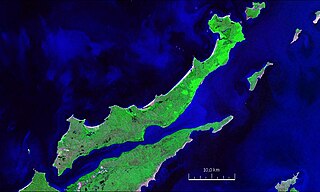
The Yolngu or Yolŋu are an aggregation of Aboriginal Australian people inhabiting north-eastern Arnhem Land in the Northern Territory of Australia. Yolngu means "person" in the Yolŋu languages. The terms Murngin, Wulamba, Yalnumata, Murrgin and Yulangor were formerly used by some anthropologists for the Yolngu.
The Wessel Islands is a group of uninhabited islands in the Northern Territory of Australia. They extend in a more or less straight line from Buckingham Bay and the Napier Peninsula of Arnhem Land, and Elcho Island, to the northeast. Marchinbar Island is the largest of the group. Other islands include Elcho Island, Rimbija Island, Guluwuru, Raragala, Stevens Island, Burgunngura, Djeergaree, Yargara, Drysdale Island, Jirrgari Island, Graham Island, Alger Island, Abbott Island, and Howard Island.

Elcho Island, known to its traditional owners as Galiwin'ku (Galiwinku) is an island off the coast of Arnhem Land, in the Northern Territory of Australia. It is located at the southern end of the Wessel Islands group located in the East Arnhem Region. Galiwin'ku is also the name of the settlement where the island's largest community lives. Elcho Island formed part of the traditional lands of the Yan-nhaŋu, according to Norman Tindale. According to J. C. Jennison, the Aboriginal inhabitants were the Dhuwal, who called themselves the Kokalango Mala

The Tharawal people and other variants, are an Aboriginal Australian people, identified by the Yuin language. Traditionally, they lived as hunter–fisher–gatherers in family groups or clans with ties of kinship, scattered along the coastal area of what is now the Sydney basin in New South Wales.
The Warndarrang people, (waɳʈaraŋ), also spelt Warndarang, Wanderang, and other variants were a predominantly coastal Aboriginal Australian people of eastern Northern Territory. Though extinct as a distinct ethnolinguistic group, their descendants survive among the neighbouring Nunggubuyu.

The Wadandi, also spelt Wardandi and other variants, are an Aboriginal people of south-western Western Australia, one of fourteen language groups of the Noongar peoples.
The Mutumui were an indigenous Australian people of northern Queensland.
The Dingaal people, also known as Walmbarddha or Walmbaria, are an Aboriginal Australian people of Cape York Peninsula in northern Queensland.
The Yan-nhaŋu, also known as the Nango, are an indigenous Australian people of the Northern Territory. They have strong sociocultural connections with their neighbours, the Burarra, on the Australian mainland.
The Dangu are an Aboriginal Australian people of Arnhem Land, in the Northern Territory, one of many Yolŋu peoples. They are, according to Norman Tindale, to be carefully distinguished from the Djaŋu.
The Dhuwala are an indigenous Australian people of eastern Arnhem Land in the Northern Territory.
The Wurango or Wurrugu are an indigenous Australian people of the Northern Territory.
The Baiyungu are an Aboriginal Australian people of the Gascoyne region of Western Australia.
The Kuyani people, also written Guyani and other variants, and also known as the Nganitjidi, are an Aboriginal Australian people of the state of South Australia who speak the Kuyani language. Their traditional lands are to the west of the Flinders Ranges.
Yadaneru, also written Jeteneru, refers to a tribe at one time thought to have existed in the Cape York Peninsula of northern Queensland.
The Yangkaal, also spelt Yanggal, are an Aboriginal Australian people of area of the Gulf of Carpentaria in the state of Queensland.
The Yukulta people, also spelt Jokula, Jukula, and other variants, and also known as Ganggalidda or Gangalidda, are an Aboriginal Australian people of the state of Queensland.
The Ngardok were an indigenous Australian people of the Northern Territory. Nothing is known of the language, which has been extinct since about WW2.
The Iwaidja are an Indigenous Australian people of the Northern Territory.



